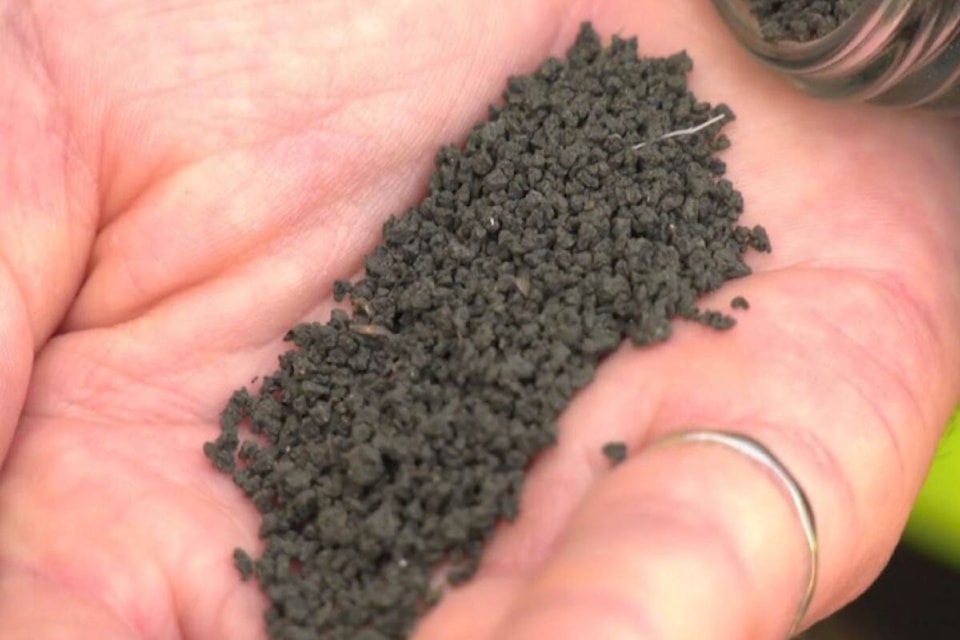Sewage that went through the Capital Regional District’s wastewater treatment process last year was eventually turned into nearly 3,000 tonnes of the small, dried pellets that make up Class A biosolids.
The CRD’s main plan for that treated sewage product is shipping it to a cement plant in Richmond where it’s used as an alternative fuel source. That was made possible thanks to the CRD giving the Lafarge plant a capital investment of $850,000, which helped built infrastructure that enabled the site to receive the biosolids.
However, the plant took in just two per cent of the Capital Region’s Class A biosolids last year. Lafarge accepted 67 of the 2,908 tonnes of Class A biosolids produced last year, and received zero tonnes through the first three months of this year due to ongoing issues.
The partnership has faced challenges in recent years, mainly due to equipment breaking down and other issues at the cement plant, although the CRD was also at fault for a short period last year when its biosolids didn’t meet the plant’s requirements.
Lafarge took 25 tonnes of biosolids in April before another equipment malfunction occurred. The CRD produces about 10 tonnes of the treated-sewage-derived pellets every day.
The contract with Lafarge will now be presented to the environmental services committee next month after the CRD board supported a motion by director Barb Desjardins.
“We have had a dysfunctional relationship with our primary source that was to receive our biosolids,” the Esquimalt mayor said at the Wednesday (May 8) board meeting.
Black Press Media asked the CRD if the contract that awarded the $850,000 included any conditions Lafarge must meet, and if it included penalties if the company didn’t meet those benchmarks.
A CRD spokesperson said that since the board has asked to see the contract, those details won’t be made public until directors see them first. The official also noted the partnership was the CRD’s doing.
“It was the board who wanted an alternative to in-region land application, staff found this alternative but Lafarge did not ask for our biosolids, we found them, so not surprising we would pay some of the costs of them being able to receive them,” CRD spokesperson Andy Orr said.
It’s been frustrating the region has been unable to see its biosolids used consistently at the Lafarge plant, CRD board chair Colin Plant said when asked if he thought the partnership was yielding a good return on investment.
“I remain hopeful we will see Lafarge come back online and receive our biosolids as we await provincial approval for our long-term plan,” he said in an email.
The discussion about the Lafarge contract came as the board was presented the long-term biosolids management strategy, which must be approved and submitted to the province by June 18.
Staff on Wednesday acknowledged the short-term contingency plans have faced challenges. Many of those strategies make up the long-term plan.
The board endorsed a portfolio of long-term options that will be prioritized on a tiered system.
The top option is to thermally break down the biosolids at a Hartland landfill processing site, but such a pilot facility is still years away from coming online. The board voted to also explore other industrial partners who may want to use CRD biosolids for combustion.
A second tier of options that will send biosolids out of the region will be used in conjunction with the thermal facility’s rollout over the next decade. Those include the current strategies of sending them to the Richmond cement plant and to reclamation projects, like one near Cassidy that’s been taking CRD biosolids. The latter has led to criticism from the Regional District of Nanaimo, which says the CRD should find beneficial uses for its biosolids within its own borders.
A third section of the plan includes contingency options for when the first two tiers are unavailable and would require approval from the board and First Nation consultation before they could be used. Tier three options would take place within the CRD and include industrial land reclammation, forest fertilization and landfilling them at Hartland.
Staff said they’re confident the first two tiers provide enough options that the region wouldn’t have to resort to tier three.
The board’s endorsement of the plan went against the calls from groups like Biosolids Free BC, requested that the board not include any land application of biosolids in the long-term strategy. Philippe Lucas, the group’s founder, told the board applying biosolids to the land is clearly “too risky for the environment and for the public health of residents.”
Biosolids Free BC and others in the CRD have raised concerns about the impacts of microplastics, PFAS and other contaminants in the pellets.
“Biosolid Free BC and the Peninsula Biosolids Coalition all share concerns that the slow pace of contracting, permitting and construction of the new pilot thermal site continues to put our environment at risk, either through disposal at Hartland landfill or in Cassidy within just a few hundred metres of the Nanaimo river,” Lucas told this paper.
READ: CRD biosolids maker denies claims its products harmed Texas farmers
READ: Groups criticize CRD’s pace in advancing thermal biosolid-disposal facility
